| This article contains promotional content. Please help improve it by removing promotional language and inappropriate external links, and by adding encyclopedic text written from a neutral point of view. (January 2023) (Learn how and when to remove this message) |
| Downtown Santa Ana Historic Districts (North, Government/Institutional and South, Retail) | |
| U.S. National Register of Historic Places | |
| U.S. Historic district | |
| California Historical Landmark No. 204 | |
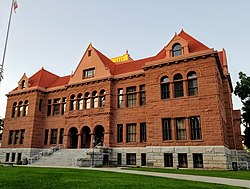 Old Orange County Courthouse Old Orange County Courthouse | |
 | |
| Location | Roughly bounded by Civic Center Dr., First, Ross, and Spurgeon Sts., Santa Ana, California |
|---|---|
| Coordinates | 33°44′54″N 117°52′5″W / 33.74833°N 117.86806°W / 33.74833; -117.86806 |
| Area | 24.5 acres (9.9 ha) |
| Built | 1877 |
| Architect | multiple |
| Architectural style | Late 19th and 20th Century Revivals, Moderne, Mission/Spanish Revival |
| NRHP reference No. | 84000438 |
| CHISL No. | 204 |
| Added to NRHP | December 19, 1984 |
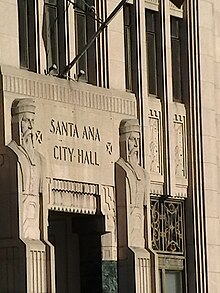
Downtown Santa Ana (DTSA), also called Downtown Orange County, is the city center of Santa Ana, the county seat of Orange County, California. It is the institutional center for the city of Santa Ana as well as Orange County, a retail and business hub.
The Downtown Santa Ana Historic Districts are listed with the National Trust for Historic Preservation and consist of numerous historic buildings across the area.
History
The City of Santa Ana was established in 1869 by William Spurgeon on 74.27 acres (300,600 m) of land purchased from the old Spanish land grant, Rancho Santiago de Santa Ana. The County of Orange was formed in 1889 by William Spurgeon and James McFadden.
Santa Ana was chosen as the county seat of government because of its larger growth as a town compared to surrounding towns such as Orange. The Old Orange County Courthouse was built in 1901. The surrounding old town buildings make up the Santa Ana Historical Downtown.
Location
City studies and merchant associations generally define Downtown as the area between Ross Street on the west, Minter Street on the east, First Street on the south and Civic Center Drive on the north.
Neighborhood organizations define Downtown more narrowly, extending only as far east as Main Street, with the area east of Main part of the Lacy neighborhood; the Santa Ana Regional Transportation Center train and bus station is located at the east end of Lacy along Santiago Avenue.
Sub-districts
Downtown consists of several sub-districts: an institutional area including the Civic Center, the Artists Village, Calle Cuatro and the East End.
Civic Center
Main article: Santa Ana Civic CenterThe Santa Ana Civic Center, also known as the Orange County Civic Center, anchors the west side of Downtown and is home to city, county and federal buildings, including:
City:
- Santa Ana City Hall (Civic Center Plaza)
- Santa Ana Civic Center Plaza (Ross, Civic Center, Santa Ana Blvd, Flower)
- Santa Ana Public Library (Civic Center Dr. & Ross)
County:
- Santa Ana Transit Terminal – Orange County Transportation Authority (OCTA) (Santa Ana Blvd & Ross)
- Old Orange County Courthouse (Civic Center, Broadway, Sycamore, Santa Ana Blvd.)
- Orange County Courthouse (Civic Center Plaza)
- Orange County Public Law Library (Civic Center Plaza)
Federal:
- Ronald Reagan Federal Building and United States Courthouse (4th & Broadway)
- Fourth District Court of Appeals (Civic Center Plaza on the corner of Santa Ana Blvd & Ross)
- Office of the District Attorney (Near the corner of Ross & Civic Center)
- Consulate of Mexico (Near Civic Center & Broadway intersection)
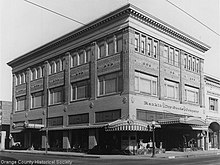
Fourth Street/Calle Cuatro
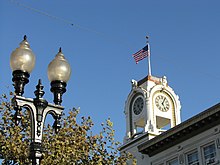
Hospitality, entertainment and retail in Santa Ana's historic Downtown are centered along historic Fourth Street, also known locally by its equivalent name in Spanish, Calle Cuatro. Fourth Street stretches from the Civic Center in the west. The West End, located between Ross Street, Broadway, and West 4th Street, across from the Ronald Reagan Building, has lounge cafés, restaurants, bars, concert theaters and other retail. The middle section of Calle Cuatro (roughly from Main east to Spurgeon) has retailers

The Rankin Building, 117W Fourth Street at Sycamore, is a historic building that was usually seen as a reminder of when the Downtown Santa Ana was a shopping center, with department stores such as Rankin's, Montgomery Ward (northeast corner of Main, demolished), J. C. Penney (northwest corner of Bush) and Buffums. Eventually, the area lost business to the new malls at Honer Plaza and Santa Ana Fashion Square when they opened in 1958, and later on, to South Coast Plaza.
The East End is a cultural hub, with restaurants and the refurbished Yost Theater. The Frida Cinema is a two-screen theater converted to an art-house theater showcasing films. In February 2015, the Fourth Street Market opened an indoor food hall along the lines of Grand Central Market in Downtown Los Angeles. Even further east, the Santa Ana Regional Transportation Center is located along Santiago Avenue in the Lacy neighborhood.
Artists Village
The Artists Village is an area composed of art galleries, studios, creative offices, design workshops, and several restaurants. It is located on Second Street at Broadway, in the center of Historic Downtown Santa Ana. The village extends from First Street to Fourth Street, Bush Street to Birch, and surrounding the Second Street Mall between Broadway and Sycamore Street.
It was originally proposed in the mid-1980s. In collaboration between the Santa Ana City Council, community activist Don Cribb and Cal State Fullerton’s Gallery Director Mike McGee, a plan for the Grand Central Art Center was conceived in 1994. A designated ten-square block would become the Artists Village. In the early 2000s, several developments came to the downtown including Main Street Studio Lofts, East Village, and Artists Village lofts. The Artists Village has restaurants, shops and art institutions, including Cal State Fullerton Grand Central Art Center and the Orange County Center for Contemporary Art.
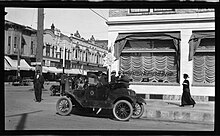
Historic districts
Located across several of the aforementioned sub-districts, the Downtown Santa Ana Historic Districts are several historic districts listed as one entry in the National Register of Historic Places since 1984, covering 24.5-acre (9.9 ha) and characterized by a number of Art Deco buildings as well as two old movie houses (The West End and the Fox West Coast). The county's first courthouse, now a museum, is located at Civic Center and Broadway streets, as is the Howe-Waffle House and Medical Museum, now the Santa Ana Historical Preservation Society.
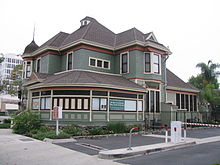
The county's first theater, Walker's Theater, was built in 1909 on Main and Second streets adjacent to the old City Hall. The Main Street Studio Lofts is located on where the county's first movie house was used to be. Old Santa Ana was designated a California Historic Landmark (No. 204) on June 20, 1935.
Events
The village has several weekly, monthly, and annual events. Some of these events include:
- 1st Saturday Downtown Art Walk
- Noche de Altares, largest free day of the dead celebration in California (the first Saturday of November)
- Fiesta Patrias (September)
- Savor Santa Ana
- OC Pride Festival
- Viva la Vida
- Patchwork Craft Fair
- Golden Years Vintage Market
- Boca de Oro Arts & Literature Festival
- Sound Downtown
- The Blading Cup (every November)
Old Santa Ana California Historical Landmark 204
National historic district
The National Register of Historic Places states that the Santa Ana Historical Downtown District is 'roughly bounded' by Civic Center Drive, 1st Street, Ross and Spurgeon. The historic district nomination form has a list of contributing properties and detailed maps of the area. The district consists of two sections with a total of 99 buildings that remain from the commercial code of Santa Ana. The buildings date from the late 1870s to the post earthquake reconstructions of 1934. The district is divided into two parts, north and south, due to a 'break' in the historic integrity.
Historic Landmark
Historic Landmark at the site reads:
Portola camped on bank of Santa Ana River in 1769. Jose Antonio Yorba, member of expedition, later returned to Rancho Santiago de Santa Ana. El Camino Real crossed river in this vicinity. Place was designated Santa Ana by travelers, and known by that name until present town of Santa Ana was founded.
— Erected by California State Park Commission. (Marker Number 204.)
See also
References
- "National Register Information System". National Register of Historic Places. National Park Service. March 13, 2009.
- "CHL # 204 Old Santa Ana Orange". www.californiahistoricallandmarks.com. Retrieved February 21, 2023.
- TAXIN, AMY; TULLY, SARAH; ROWE, JEFF (March 19, 2006). "Urban centers of attention". Orange County Register. Retrieved June 29, 2019.
- Santa Ana Downtown complete streets plan (PDF). City of Santa Ana. January 2016. p. 25. Retrieved January 17, 2020.
- "Neighborhoods, "Lacy"" (PDF). City of Santa Ana. Retrieved January 17, 2020.
- "Orange County Civic Center Authority | OC Public Works: Orange County, California".
- Nagourney, Adam; Medina, Jennifer (October 11, 2016). "This City Is 78% Latino, and the Face of a New California". The New York Times. ISSN 0362-4331. Retrieved January 17, 2020.
- "The Montgomery Ward Building on the corner of E. Fourth Street and N. Main Street in the heart of downtown Santa Ana in 1954". oac.cdlib.org. Retrieved March 27, 2024.
- "Historic Floral Park - Before malls and "big box" stores, where did Orange County people do their Christmas shopping? Downtown Santa Ana! Pictured is the 100 block of E. 4th Street, including J. C. Penney in the foreground and Montgomery Ward on the near side of the intersection with Main St. That "Monkey Wards" building was a real art deco beauty. It's now a parking lot. Read about Christmas in the 1930s in the Floral Park Gazette (page 11) at Floralpark.com/news. | Facebook". www.facebook.com. Retrieved March 27, 2024.
- "Downtown Santa Ana: Orange County's hub for vibrant arts and entertainment". Orange County Register. March 2, 2015. Retrieved May 15, 2018.
- Harold M. Thomas (April 1984). "National Register of Historic Places Places Inventory – Nomination Form: Downtown Santa Ana Historic Districts (North, Government/Institutional and South, Retail)" (PDF). National Park Service. Retrieved January 20, 2016. Accompanying 93 photos.
- "Old Santa Ana Historical Marker". www.hmdb.org. Retrieved February 21, 2023.
External links
- City of Santa Ana
- Santa Ana Public Library Archived June 25, 2009, at the Wayback Machine
- Santa Ana Historical Preservation Society
- Santa Ana History Room Photograph Collection
- Cinematic Treasures—Closed Movie Theaters, Santa Ana
- National Register of Historic Places
| Santa Ana, California | |||||||||
|---|---|---|---|---|---|---|---|---|---|
| History | |||||||||
| Education |
| ||||||||
| Culture | |||||||||
| Points of interest |
| ||||||||
| Transportation |
| ||||||||
